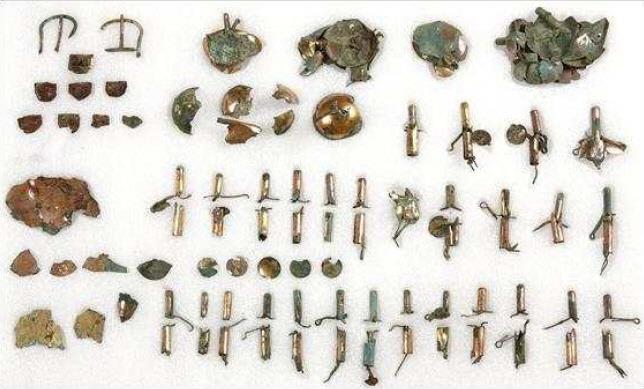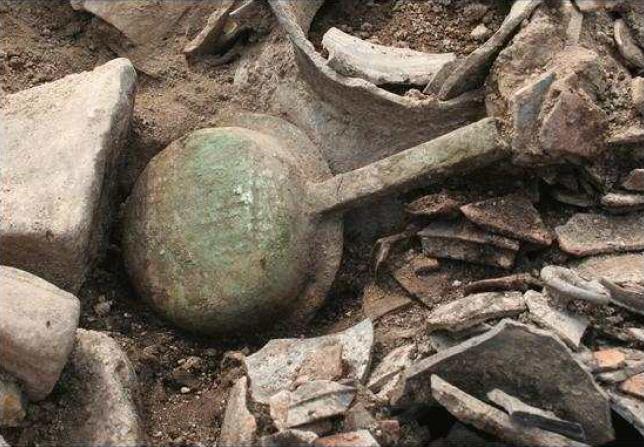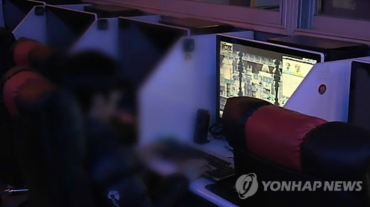
This photo, released by the Cultural Heritage Administration on May 27, 2020, shows a variety of horse ornaments that South Korean archaeologists unearthed from the Hwangnamdong Tumulus No. 120-2 from the Silla Kingdom (57 B.C.-A.D. 935) in the ancient city of Gyeongju, southeastern South Korea.
GYEONGJU, May 27 (Korea Bizwire) — A pair of ceremonial gilt-bronze shoes, believed to have been made between the late 5th century and early 6th century, were unearthed from an excavation site at a royal tomb complex in southeastern South Korea, cultural heritage authorities said Wednesday.
The Cultural Heritage Administration (CHA) said researchers have unearthed the artifacts — a pair of gilt-bronze shoes, a silver ornament piece made to be attached on belts and a slew of equestrian adornments among others — from the Hwangnamdong Tumulus No. 120-2 excavation site inside the Daereungwon, a Silla-era royal tomb complex in Gyeongju, some 371 kilometers southeast of Seoul.
The last time a pair or gilt-bronze shoes, presumed to have been used for funeral rituals, were unearthed at an ancient Silla tomb was in 1977 at another site in the same city.
The relics were presumed to have been possessions of either an aristocrat or person with royal blood. Researchers said the shoes, which appeared to be in relatively good condition, were discovered near the feet of the deceased.
The sex of the deceased, according to researchers, was difficult to discern at the moment.
Gyeongju was the capital of Silla (57 B.C.-A.D. 935), the kingdom that eventually unified the Korean Peninsula under its rule. A vast number of archaeological sites and cultural properties from this period remain in the city.

This photo, released by the Cultural Heritage Administration on May 27, 2020, shows a bronze iron that South Korean archaeologists unearthed from the Hwangnamdong Tumulus No. 120-2 from the Silla Kingdom (57 B.C.-A.D. 935) in the ancient city of Gyeongju, southeastern South Korea.
According to researchers, both pairs of shoes had T-shaped carve-out patterns on the surface, decorated each with gilt-bronze “dalgae,” a bracelet-like ornament made with beads.
Other items discovered, presumed to have been buried along with the deceased as personal belongings, included a gilt-bronze horse saddle, a bronze iron, a Korean traditional steel cauldron and various earthenware.
“The items usually reveal the social status of the deceased. From the discovery of the gilt-bronze shoes, it’s generally assumed that the deceased was of royal lineage,” said Kim Kwon-il, a senior researcher at the Silla Cultural Heritage Research Institute.
In the vicinity of site 120-2 were two other burial sites, with the larger site 120 to the north and 120-1 even further to the north.
According to the institute, burial site 120 was known to have been discovered during the era of Japanese colonial rule, but it was later abandoned and forgotten, with three houses later built over the area and remaining until recently.
The excavation was part of a project between the Cultural Heritage Administration and the Gyeongju city aimed at restoring major historic ruins linked to the capital of the Silla dynasty.
Gyeongju is home to three UNESCO World Cultural Heritage sites: Bulguksa Temple and Seokguram Grotto, Yangdong Village, and the Gyeongju Historic Areas. Daeruengwon is part of the Gyeongju Historic Areas.
(Yonhap)






